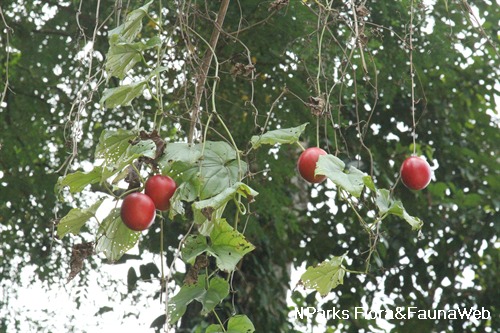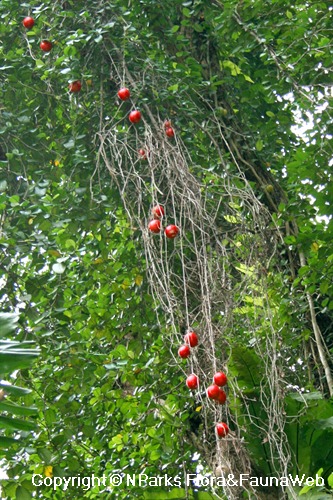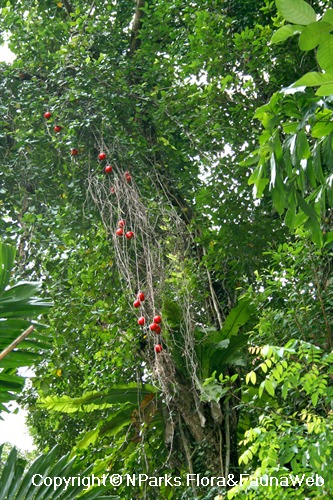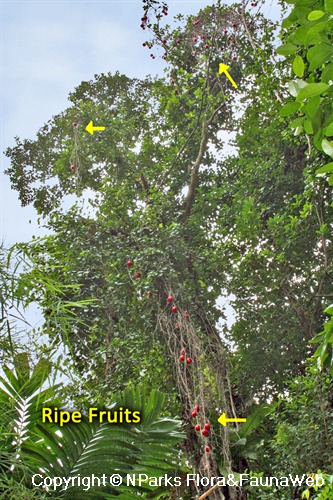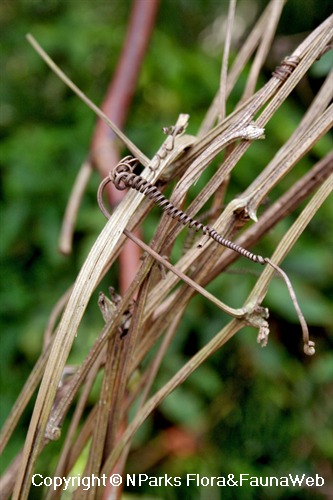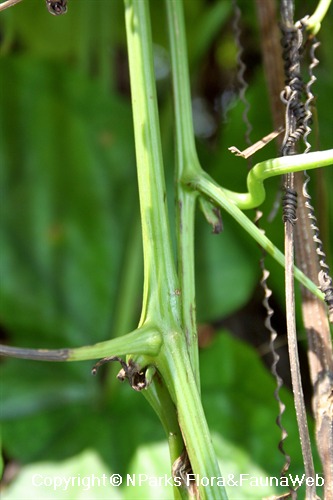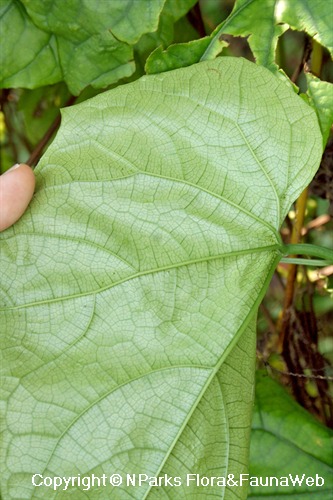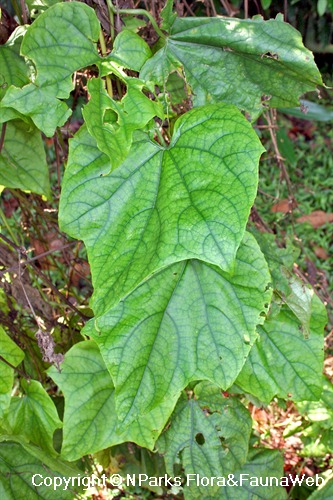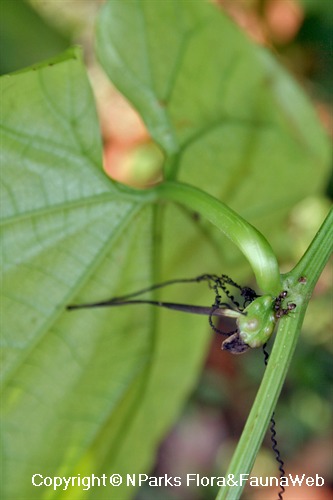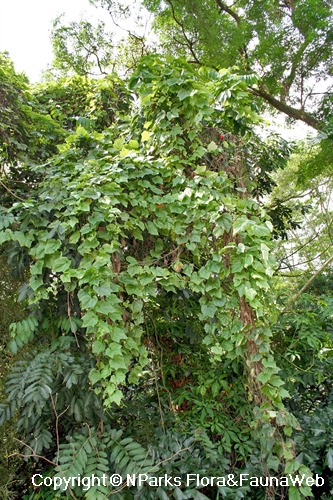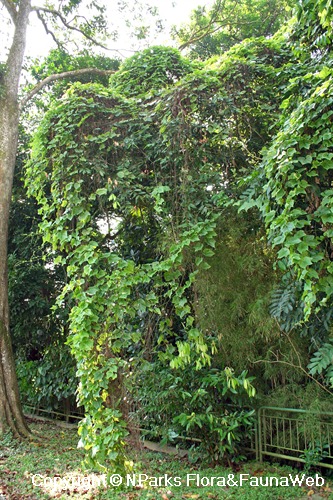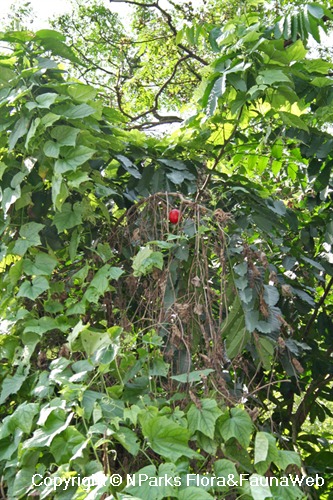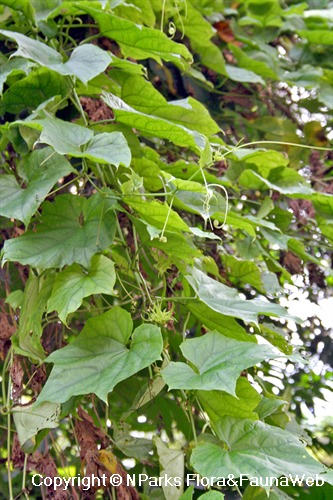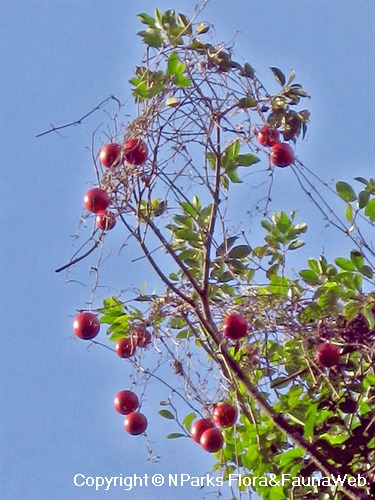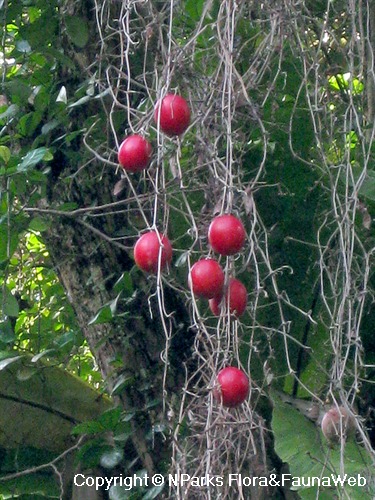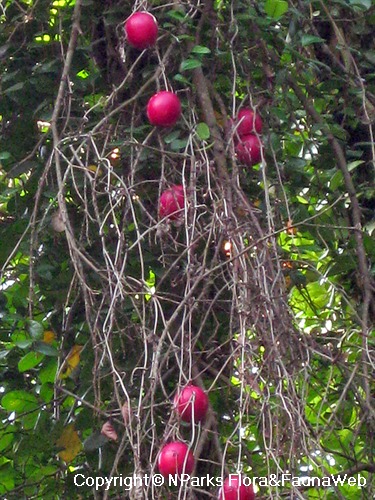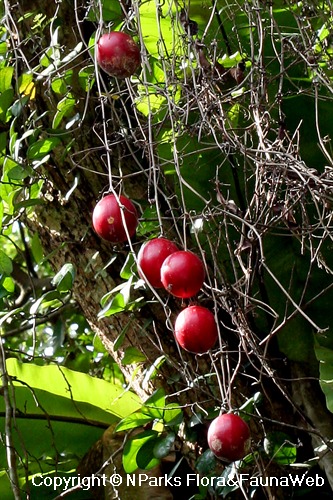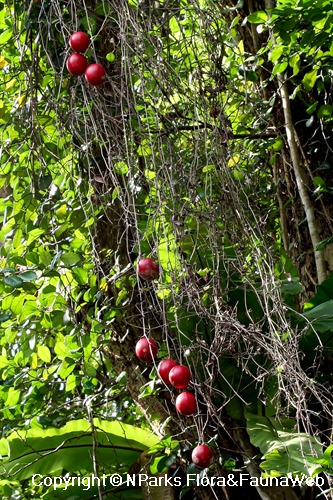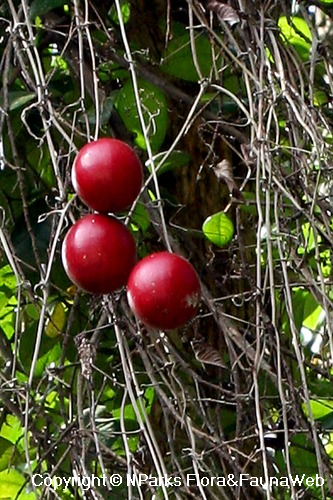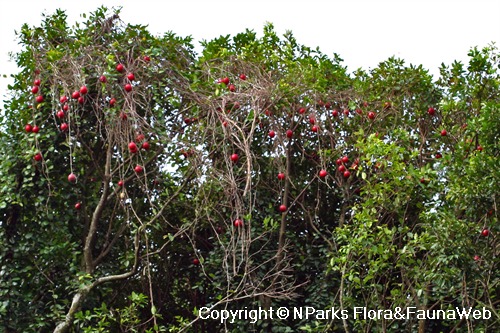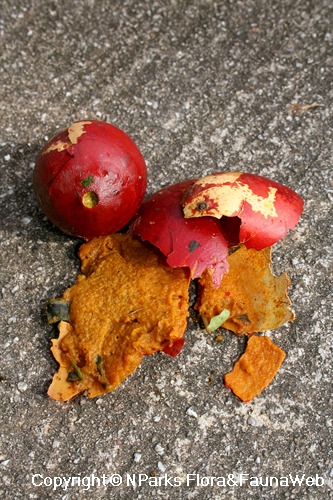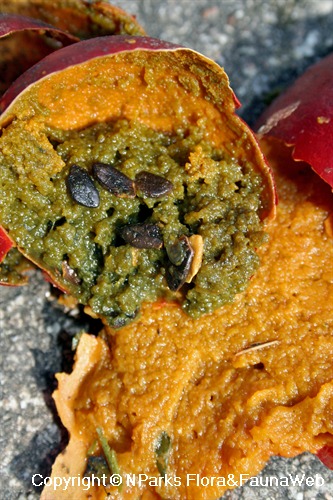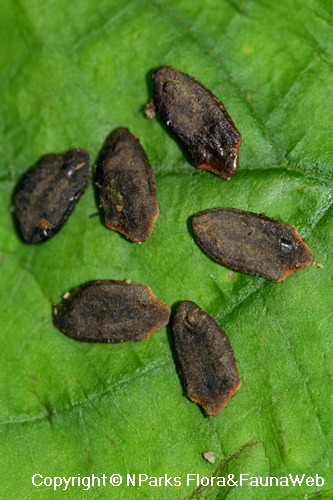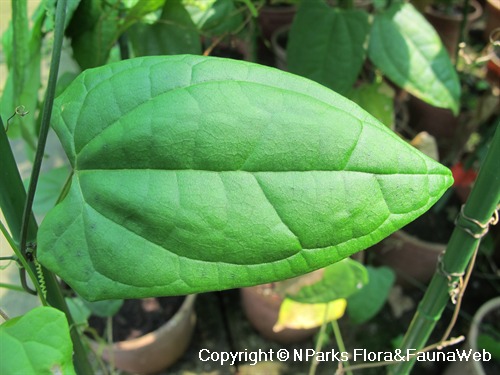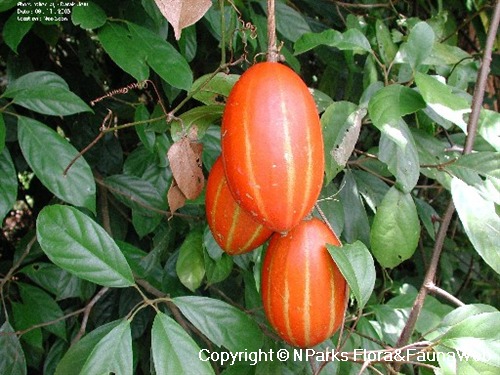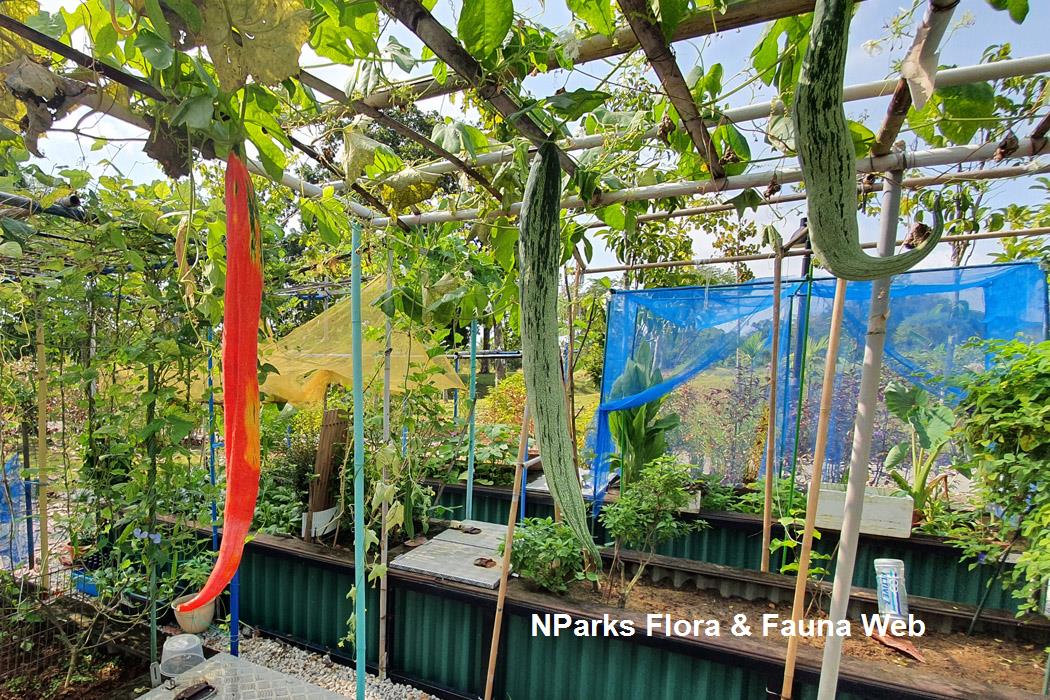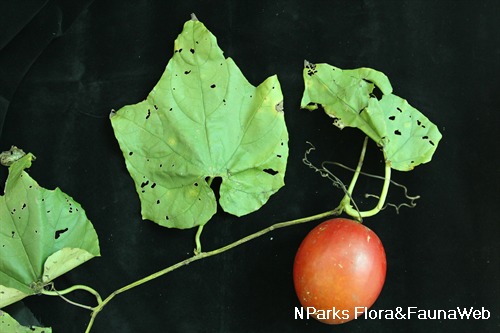
Back
Trichosanthes quinquangulata A. Gray
| Family Name: | Cucurbitaceae |
| Common Name: | Kabalonga, Patolang-gubat, Buap Liam, 五角叶栝楼 |
Name
Classifications and Characteristics
| Plant Division | Angiosperms (Flowering Seed Plants) (Dicotyledon) |
|---|---|
| Plant Growth Form | Climber |
| Mode of Nutrition | Autotrophic |
| Plant Shape | Irregular |
Biogeography
| Native Distribution | Southern China, Taiwan, Indochina, Peninsular Malaysia, Singapore, Indonesia |
|---|---|
| Native Habitat | Terrestrial (Secondary Rainforest, Disturbed Area / Open Ground) |
| Preferred Climate Zone | Tropical, Sub-Tropical / Monsoonal |
Description and Ethnobotany
| Growth Form | Herbaceous tendril climber, scrambling over vegetation and reaching to tree tops. |
|---|---|
| Foliage | Leaves broadly ovate, 10-20cm across, 5-lobed (where the 2 lobe "points" nearest the leaf petiole are much shallower and hence less prominent). Abaxial surface covered by dense network of recticulate veins. |
| Stems | Slender, non-woody, grooved and somewhat angular. |
| Flowers | White. Species is monoecious, with male and female flowers found separately on the same plant. Male flowers produced in 8-10 flowered racemes (17-30cm long), where 1 or 2 flowers are open at any one time. Female flowers solitary |
| Fruit | Fleshy pepo, globose, 8-10cm across, produced on drying stems, ripen from green to smooth scarlet-red. Skin thin and shell-like, enclosing bright orange juicy pulp and numerous black to greyish-brown triangular-ovate seeds. |
| Habitat | Lowland forest margins, thickets, old clearings, and roadsides. |
| Etymology | Genus epithet 'Trichosanthes' derived from Greek terms of 'trichos' (hairy) and 'anthos' (flowers), a reference to the velvety flowers produced by this genus. Species epithet 'quinquangulata' means '5-angled', alluding to the 5-pointed lobed leaves. |
| Ethnobotanical Uses | Food (Herb or Spice) Others: Medicinal: In Philippines, seeds from ripe fruits grinded and fried in coconut oil, before the cooled fluid is applied onto itchy skin lesions. Powdered seeds mixed into wine and drunk as a folk remedy for stomachaches. Seeds also yield an abortifacient (induces abortions), immuno-suppressive, anti-tumor and ribosome-inhibiting protein called trichosanthin, which is being investigated as a promising anti-HIV drug. |
Landscaping Features
| Landscaping | It is suitable for growing on trellises in parks for their attractive bright red, round fruits and five-angled leaves. |
|---|---|
| Desirable Plant Features | Ornamental Foliage, Ornamental Fruits |
| Landscape Uses | Parks & Gardens, Small Gardens, Trellis / Arbour / Pergola |
| Thematic Landscaping | Naturalistic Garden |
| Usage Hazard - Cons Remarks | Plant may have symbiont ants. |
Fauna, Pollination and Dispersal
| Pollination Method(s) | Biotic (Fauna) (Insects (Ant, Beetle, Fly, Thrip, Wasp)) |
|---|---|
| Seed or Spore Dispersal | Biotic (Fauna) |
Plant Care and Propagation
| Light Preference | Full Sun, Semi-Shade |
|---|---|
| Water Preference | Moderate Water |
| Rootzone Tolerance | Well-Drained Soils, Fertile Loamy Soils |
Foliar
| Foliage Retention | Drought / Semi-Deciduous |
|---|---|
| Mature Foliage Colour(s) | Green |
| Mature Foliage Texture(s) | Thin, Leathery |
| Foliar Modification | Foliar Tendril, Food Bodies for Insects |
| Foliar Type | Simple / Unifoliate |
| Foliar Arrangement Along Stem | Alternate |
| Foliar Attachment to Stem | Petiolate |
| Foliar Shape(s) | Non-Palm Foliage (Ovate, Deltoid) |
| Foliar Venation | Pinnate / Net |
| Foliar Margin | Palmately Lobed |
| Foliar Apex - Tip | Acuminate |
| Foliar Base | Auriculate |
| Typical Foliar Area | Mesophyll ( 45cm2 - 182.25 cm2 ) |
Non - Foliar and Storage
| Stem Type & Modification | Herbaceous |
|---|---|
| Root Type | Underground (Fibrous Root) |
Floral (Angiosperm)
| Flower & Plant Sexuality | Unisexual Flowers , Monoecious |
| Flower Colour(s) | White |
|---|
| Flower Grouping | Cluster / Inflorescence |
| Flower Symmetry | Radial |
| Inflorescence Type | Raceme |
| Flowering Habit | Polycarpic |
Fruit, Seed and Spore
| Mature Fruit Colour(s) | Red |
|---|---|
| Mature Fruit Texture(s) | Leathery |
| Fruit Classification | Simple Fruit |
| Fruit Type |
Image Repository
Others
| Master ID | 29687 |
|---|---|
| Species ID | 3996 |
| Flora Disclaimer | The information in this website has been compiled from reliable sources, such as reference works on medicinal plants. It is not a substitute for medical advice or treatment and NParks does not purport to provide any medical advice. Readers should always consult his/her physician before using or consuming a plant for medicinal purposes. |


